|
"Despite decades of oppression,
she still persists. She is tossed by
the waves, but she does not sink."
Mermaid Iconography
Swimming through the Seven Seas
and charming men with their siren songs, mermaids
have long been a subject of myth, legend, and
beauty. Ranging across cultures, there is plenty of
symbolism and meaning found within the mermaid's
body, and they're much more than just a pretty face.
In fact, some cultures didn't
even believe them to have pretty faces at all. Often
representing danger, temptation, sensuality and
duality, the history and meanings behind the aquatic
folk are as deep as the oceans themselves.
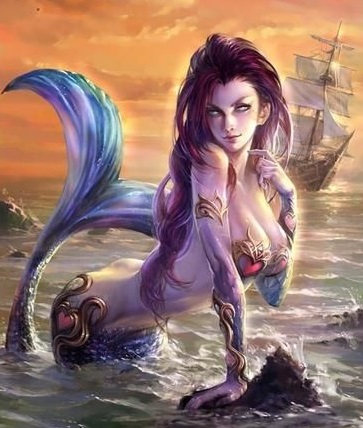
Mermaids are the admired descendants of Aphrodite
and Venus, the goddesses of both love and beauty. In
this context, mermaids can be a celebration of inner
and outer beauty.
The iconography of the mermaid has sensual power.
Bare-breasted curves and long flowing hair are often
symbols of feminine beauty. During the Victorian era
when women were deemed to be covered up and wear
their hair secured into conservative styles,
mermaids let their wavy tresses down, tossed the
rules aside, and playfully enticed men at sea.
Adding to their loveliness, mermaids aren't shy
about baring their bodies. Although we now accept
the idea they would cover their breasts with shells,
that wasn't always the thought.
Symbolically, mermaid images
are meant to reflect seduction, allure, and
flirtation. Like the ancient Greek Sirens, mermaids
are beautiful, charming, and provocative. They
are magical and spell-binding.
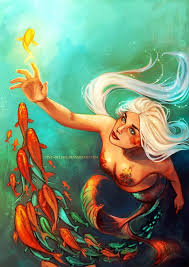
Ancient sailors were enticed by
these beautiful mistresses of the sea. They quickly
fell in love with their charms and beauty. Mermaids
were renowned for their feminine essence and epitome
of female beauty. In form and feature, mermaids
radiated sensual energy.
They were shape-shifting,
seafaring temptresses who were truly provocative and
irresistible yet unattainable and untouchable. The
fact that they were unable to be conquered or tamed
made them even more desirable.
Mermaids, then, are loved and
feared at the same time. Naturally mysterious and
mystical, mermaids are from a different world. To be
with her you must give up everything you know of
your world and trust her completely. Once you give
into her allure and seductive power, there is no
looking back.
Mermaid Symbolism and Meaning
Stella the Siren: Real Life Mermaid
What Hides Behind the Mermaid Myth?
Watch Real Mermaids Swimming
Sailor Superstitions
Water Beings
History of Sirens and Mermaids
Mermaid Melissa: Swimming With Dolphins
Mermaids are Officially Cooler Than Vampires
Stella the Siren: Do You Believe in Mermaids?
Mermaid Tatoos
Joni Mitchell and the Mermaid Cafe
Mermaids and Lesbians
Mermaid Folktales
A mermaid is a fabled marine
creature with the head and upper body of a human
being and the tail of a fish. Similar divine or
semidivine beings appear in ancient mythologies. In
European folklore, mermaids (sometimes called
sirens) were natural beings who, like fairies, had
magical and prophetic powers. They loved music and
often sang. Though very long-lived, they were mortal
and had no souls.
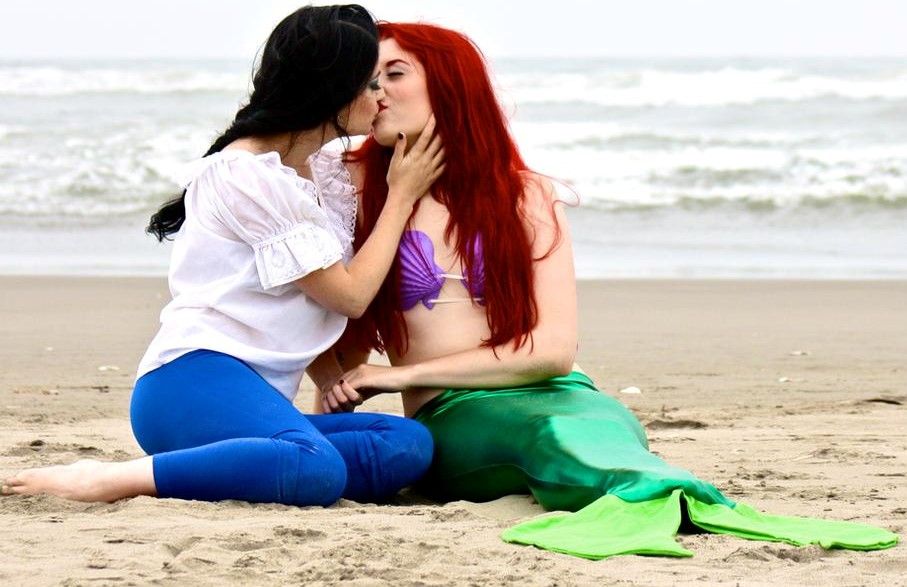
Though sometimes kindly,
mermaids were usually dangerous to man. Their gifts
brought misfortune, and, if offended, the beings
caused floods or other disasters. To see one on a
voyage was an omen of shipwreck. They sometimes
lured mortals to death by drowning, as did the
Lorelei of the Rhine, or enticed young people to
live with them underwater, as did the mermaid whose
image is carved on a bench in the church of Zennor,
Cornwall, England.
Aquatic mammals, such as the dugong and manatee,
that suckle their young in human fashion above water
are considered by some to underlie these legends.
Mermaid Tavern
Mermaid Symbolism
Mermaids and Lesbians
Mermaid Fantasy
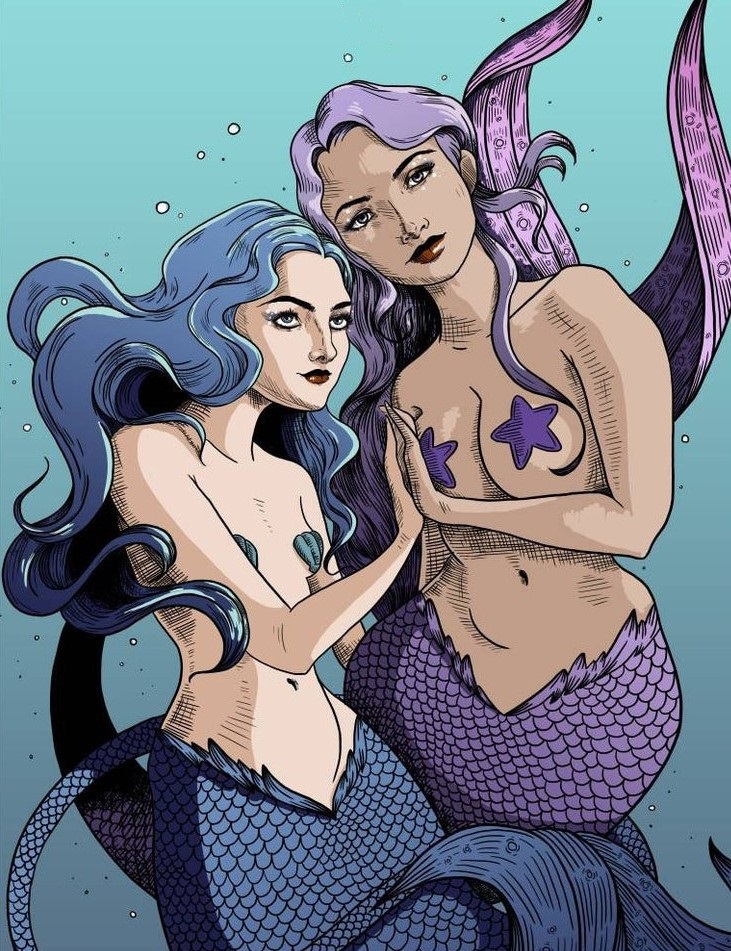
Imagining the Modern Mermaid
Swimming With Mermaids
Mermaid
Visions: Sexual Politics of Women and Water
City of Dreams: Mermaid Show
Beauty Beyond Binaries: Mermaid Trend Has Special
Meaning for Trans Women
Underwater Dance
Mermaids and Lesbians
Aquarium of Paris: Mermaid Show
Natasha Brooks: Blue Hue
Dominic Eagle: Naked Lake
Lexie Mermaid: Neree
Mermaids and Lesbians
Relaxing Mermaid Swim
Mermaids is Art and Legend
Mermaids like to sit on rocks
and use either their enchanting siren songs,
or the tried-and-true tactic of looking in a mirror
and combing their green hair while they display
their huge tits in order to lure human men (and
especially sailors and pirates and stuff) to make
love to them.
In art and legend, mermaids are
typically represented in a highly sexual manner.
They are the symbol of raw sexuality, the embodiment
of pure sensuousness.
Mermaids are described as either mortal (with or
without a soul) or fairies, so they may or may not
command powerful magic. Some can see the future,
turn their tails into long sleek legs, call up storms, sink
ships with tidal waves, and do other cool stuff.
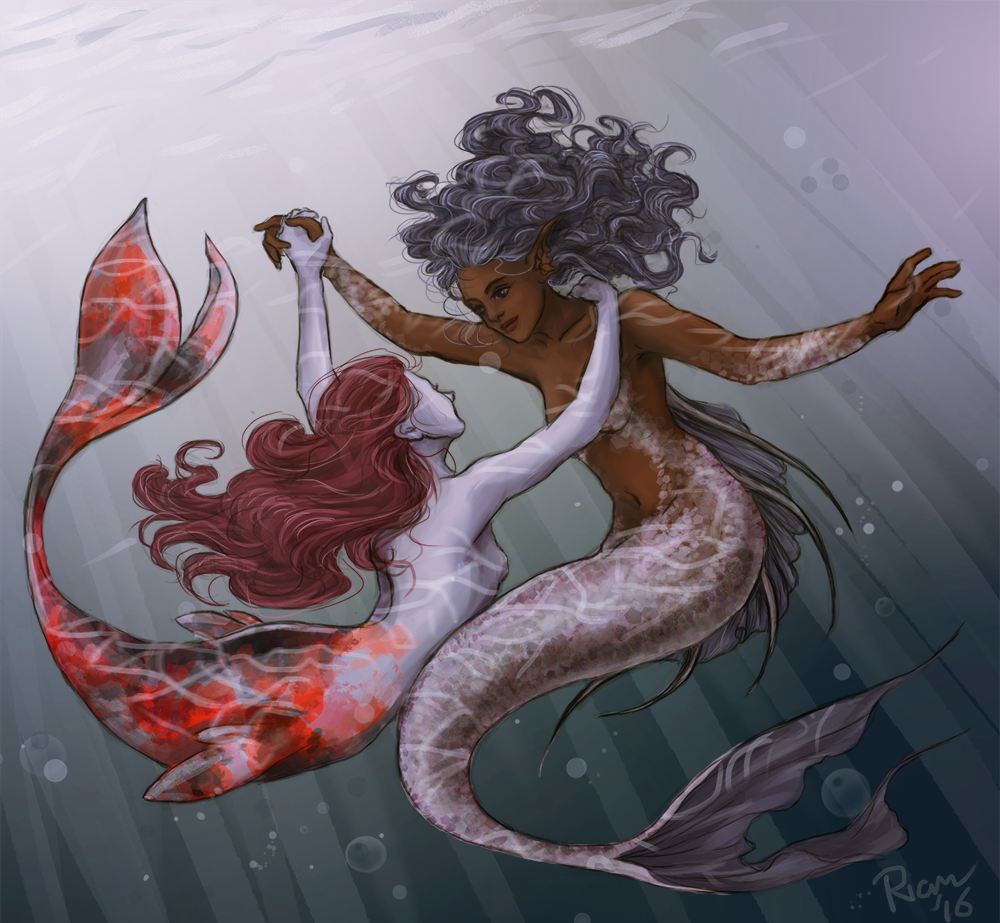
Mermaid Tavern
Mermaid Symbolism
Mermaids and Lesbians
Mermaid Fantasy
Negative Nomenclature
According to the Urban
Dictionary, a "mermaid" is a hot babe from head to
waist, and a scaly fish from the waist to the tip of
her tail.
In the on-line dating world,
the term "mermaid" tends to have a
negative connotation. "Mermaid," in that venue, is slang for a girl who will let you do
anything with her above the waist but goes into
lockdown if you try messing with anything south of
the belly button.
"Mermaid sex" describes a girl who only engages in
fellatio but does not want to have vaginal sex.
"Mermaid lesbian" is a term for a female, mainly a
straight female, who is attracted to other women,
but only from the waist up. They can either be
sexually or sensually attracted to women, but don't
like the sexual parts below the waist. This term was
coined to describe a woman who is attracted to
women, but didn't like vaginas.

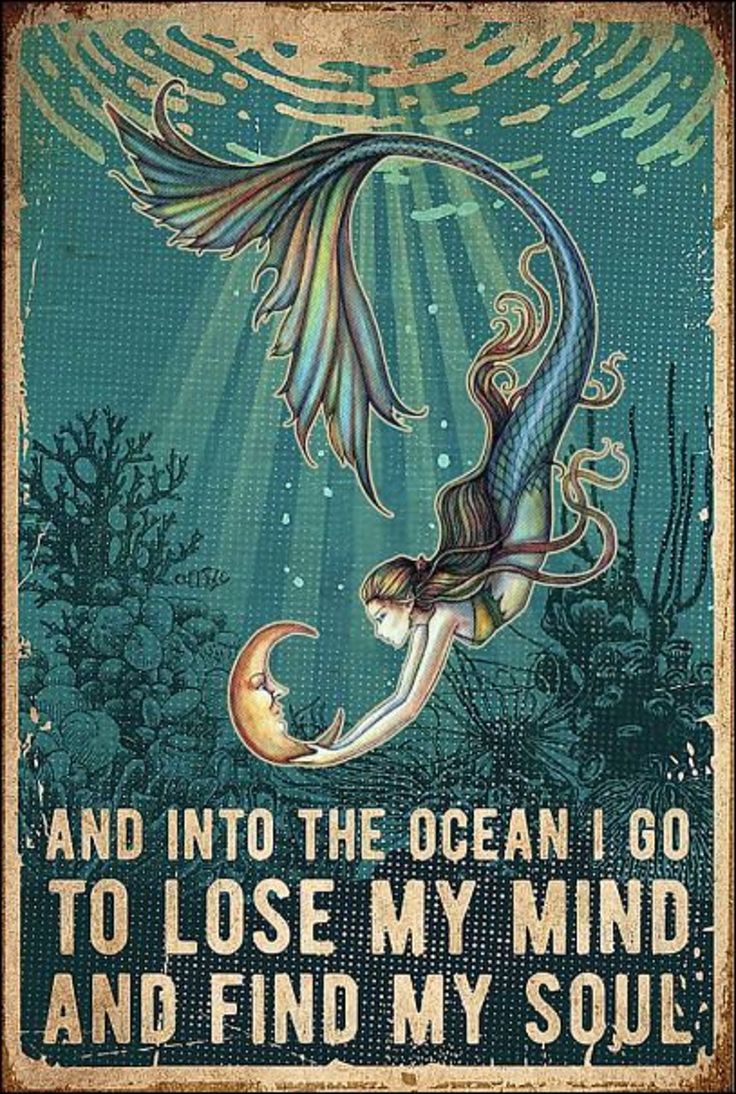
Stella the Siren: Real Life Mermaid
Mermaid Facts
Watch Real Mermaids Swimming
Lexie Mermaid: Ariel
Dominic Eagle: Naked Lake
Mermaid Melissa: Swimming With Dolphins
Types of Mermaids
Aquarium of Paris: Mermaid Show
Stella the Siren: Do You Believe in Mermaids?
Underwater Dance
Mermaid Fun Facts
Fantasy Mermaids: Lake Michigan
Lexie Mermaid: Cleo
Ecstasy and Allure
Mermaids for the
most part have always been a symbol of feminine
sensuality. They represent beauty, mystery and fantasy.
They are untamed spirits, elusive, wild, carefree, and adventurous.
They symbolize ferocious independence. They inspire visions of carnal abandon and feelings
of passion and desire. Akin to sirens, with their sexual allure and
promise of unbridled ecstasy, they tempt men and
women alike.
Mermaids have long been a
symbol of women to woman romance. In their
dedication to loving and adoring other women,
lesbians may find mermaids to be the perfect
feminine icon to embody the spirit of girl on girl
frolicking.
Mermaid Tavern
Mermaid Symbolism
Mermaids and Lesbians
Mermaid Fantasy
The image of mermaids
gracefully weaving and elegantly slithering in their
watery dance emulates the flirtatious interplay of
two women waltzing while sultry music cavorts in the
air.
For feminist lesbians, the
mermaid is a symbol of pride for those who celebrate
feminine power, an adventurous attitude, a
rebellious spirit, and ferocious independence. She
is strong, bold, confident, and aggressive. Despite
decades of oppression, she still persists. She is
tossed by the waves, but does not sink.
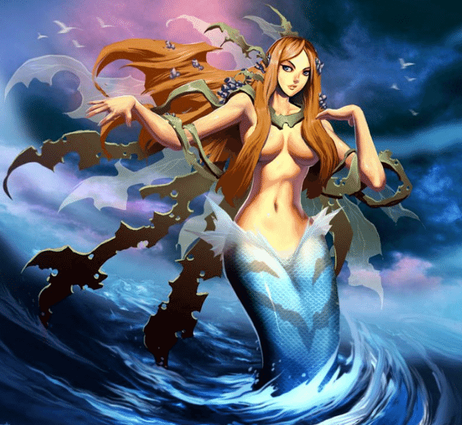
Imagining the Modern Mermaid
Mermaid Symbolism and Meaning
Stella the Siren: Real Life Mermaid
What Hides Behind the Mermaid Myth?
Watch Real Mermaids Swimming
Sailor Superstitions
Water Beings
History of Sirens and Mermaids
Mermaid Melissa: Swimming With Dolphins
Mermaids are Officially Cooler Than Vampires
Stella the Siren: Do You Believe in Mermaids?
Beauty Beyond Binaries: Mermaid Trend Has Special
Meaning for Trans Women
Mermaids and Lesbians
Mermaid Sightings
Mermaid sightings have been
reported by many sailors and pirates throughout
history. The theory is that they actually were
mistaking a manatee for a mermaid, but who knows?
Here are a few historical accounts of mermaid
sightings.
Christopher Columbus - Christopher Columbus
was the first documented account of seeing a
mermaid. He wrote that the mermaid was not as
beautiful as legend, and had a masculine face. It is
believed that it was really a dugong that he saw.
John Smith - There is a story that John
Smith, of Jamestown, sighted a mermaid. He said she
was graceful and “by no means unattractive.” It is
debatable whether it is historically accurate or
just the story of a writer.
Edward Teach – Edward Teach was an English
pirate who sailed around the West Indies. He was
famously known as Blackbeard. He was a huge man and
one of the most dangerous pirates around. In a log
book it is recorded that Blackbeard made an order to
steer clear of a certain area that he believed was
inhabited by merfolk.
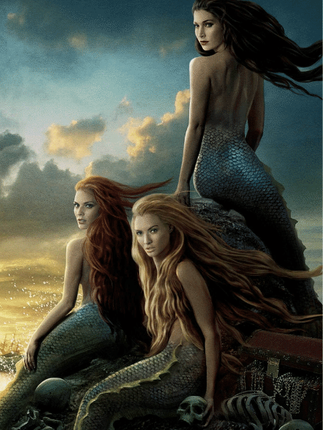
Imagining the Modern Mermaid
Swimming With Mermaids
Mermaid
Visions: Sexual Politics of Women and Water
City of Dreams: Mermaid Show
Beauty Beyond Binaries: Mermaid Trend Has Special
Meaning for Trans Women
Underwater Dance
Mermaids and Lesbians
Aquarium of Paris: Mermaid Show
Relaxing Mermaid Swim

|

|
Mermaids Explained
Real Mermaids
City of Dreams: Mermaid Show
Mermaid Myths
From Manatees to Mermaids
Mermaids in Movies
Lexie Mermaid: Neree
Melissa the Mermaid: Living Underwater
Mermaid Myth and Legend
The Mermaid Effect
Aquarium of Paris: Mermaid Show
Mermaids and Lesbians
Lexie Mermaid: Lunea
Magical Celtic Mermaid
"Come on down to the mermaid
café.
And I will buy you a bottle of wine.
And we'll
laugh and toast to nothing.
And smash our empty
glasses down."
-Joni Mitchell
Behind the Mermaid Myth
Mermaids have become a popular
trend recently, from companies selling mermaid
floats, mermaid-tail swimsuits, or mermaid-themed
makeup.
Nowadays, they are considered
an ideal of femininity, as sensual, beautiful, and
strong creatures. But it wasn’t always the case.
The figure of the mermaid has
undergone many shifts through time, from its origin
story to today’s pop culture icon. Our constant
fascination with this fictional character seems to
mirror our own ideas on gender, specifically what it
means to be a “real” woman.
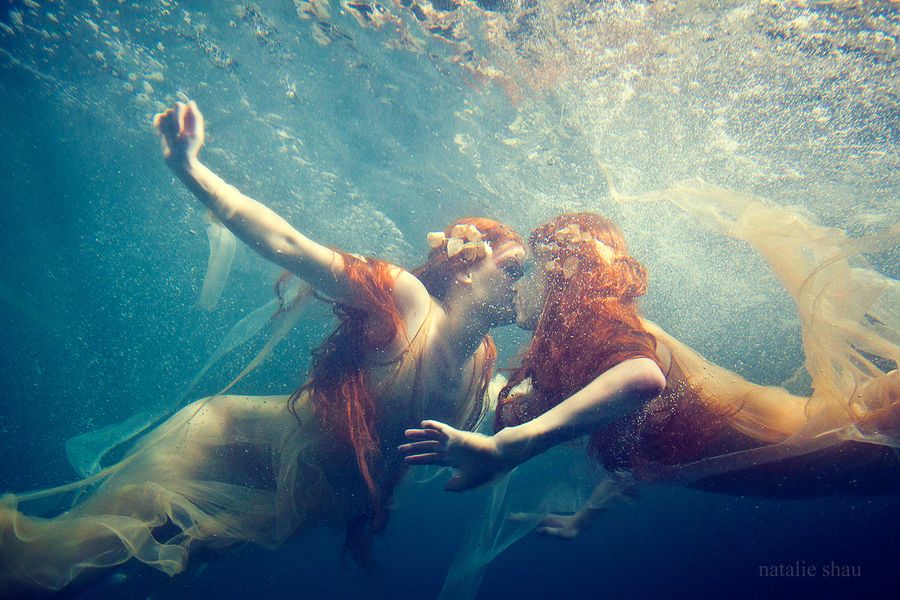
Mermaid Symbolism and Meaning
Stella the Siren: Real Life Mermaid
What Hides Behind the Mermaid Myth?
Watch Real Mermaids Swimming
Sailor Superstitions
Water Beings
History of Sirens and Mermaids
Mermaid Melissa: Swimming With Dolphins
Mermaids are Officially Cooler Than Vampires
Stella the Siren: Do You Believe in Mermaids?
Underwater Dance
Mermaid Tatoos
Joni Mitchell and the Mermaid Cafe
Mermaids and Lesbians
Mermaids first appeared as sirens in Homer’s poem
The Odyssey. They were half bird half woman, and
perceived as a threat to men, and more specifically
sailors, because of their powers. Indeed, a siren’s
singing voice was greatly feared by men at sea.
Legends said that anyone who heard a siren’s
melodious voice was sure to meet their end.
Overcome
with lust and desire, sailors would throw themselves
overboard in a vain effort to reach the enchanting
sea creatures. Ships would sink to their destruction
while the sirens kept on singing mercilessly. Their
voice was therefore the source of their power; it
was not yet their physical beauty.
Yet, when we talk about mermaids, the most iconic
remains Christian Hans Andersen’s Little Mermaid
fairytale that inspired Ariel, the Disney animation
film. It is very interesting to point out that in
both these tales, the mermaid figure becomes an
attractive water creature, who chooses to give up
her voice. In these stories, the mermaid lives
underwater and falls in love with a human prince.
Desperately yearning to join him on land, the
mermaid chooses to willingly trade her compelling
voice for human legs. She gets walk on land but is
unable to speak.
Wild Women Swimming in Nature
Irish Journey: Ice Swimmer
Jane by the Sea: Sunset
Wild Swimming: Exhilarating and Freeing
Skinny Dipping In Freezing Lake
Jane by the Sea: Full Moon
Lexie Mermaid: Neree
Swimming in Mountain Springs in Mexico
Wild Women Wild Swimming
Jane by the Sea: Summer Day
Lexie Mermaid: Lunea
Fairy Ponds
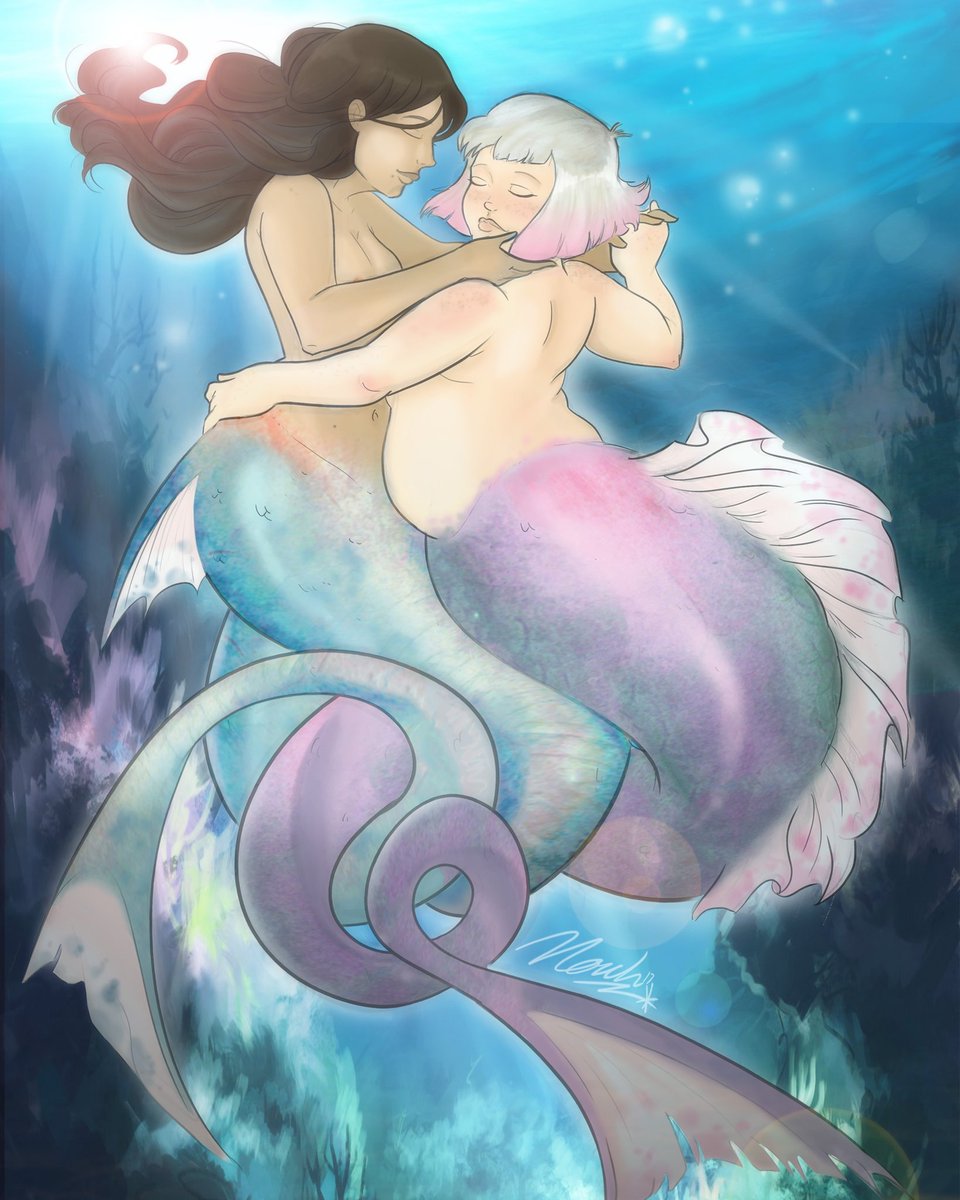
Imagining the Modern Mermaid
Swimming With Mermaids
Mermaid
Visions: Sexual Politics of Women and Water
City of Dreams: Mermaid Show
Beauty Beyond Binaries: Mermaid Trend Has Special
Meaning for Trans Women
Underwater Dance
Mermaids and Lesbians
Natasha Brooks: Blue Hue
Dominic Eagle: Naked Lake
Lexie Mermaid: Neree
Aquarium of Paris: Mermaid Show
Relaxing Mermaid Swim
We must not underestimate the symbolic weight in
this trade. The mermaid, by giving up her voice,
renounces to what was previously the source of her
powers, what made her superior to men. She renders
herself powerless in front of a male figure of
authority: her prince. The mermaid myth was
rewritten from being a dangerous predator to men to
becoming a harmless and beautiful object of
contemplation for men. She no longer lures them
underwater to their death but is the one lured out
of her natural habitat. In literature and in films,
the mermaid figure shifts from being a predator to
becoming a prey.
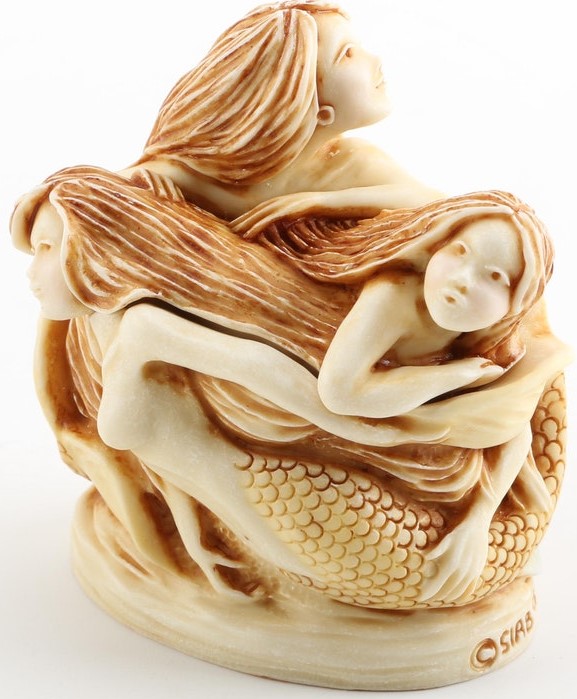
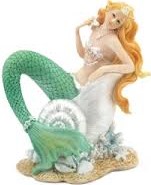
Stella the Siren: Real Life Mermaid
Mermaid Facts
Watch Real Mermaids Swimming
Vivien Solari: Nude Cold Water Swimming
Lexie Mermaid: Tropico
Natasha Brooks: Blue Hue
Dominic Eagle: Naked Lake
Mermaid Melissa: Swimming With Dolphins
Types of Mermaids
Aquarium of Paris: Mermaid Show
Stella the Siren: Do You Believe in Mermaids?
Underwater Dance
Mermaid Fun Facts
Fantasy Mermaids: Lake Michigan
This evolution is very problematic, as it seems to
tell readers and audiences that girls can only find
love, and be loved when they are beautiful but
silent, obedient, and submissive.
These fairytales do not showcase strong, independent
female characters, but characters whose personality
is rendered less important than their looks, and
whose sole goal is to be in a relationship.
However, the
recent film The Shape of Water shows a more modern
take on the mermaid myth. Elisa can be interpreted
as a mermaid figure, since she is found as a child
by a river, unable to speak. Like the traditional
mermaid tale, she had given up her voice for a human
form. At the end of the movie, when she finally
returns to her natural habitat in the water, the
scars on her neck open up as gills. Through out the
movie, Elisa follows her heart and rebels against
authority: she does not let herself be intimidated
or controlled by patriarchy.
Numerous contemporary TV shows have also
participated in giving new meaning to the image of
the mermaid: making mermaids positive and inspiring
mythical female creatures. Without a doubt, mermaids
remain fascinating popular icons, whose perception
through time reveals our own changing views on
femininity, gender, and sexuality.
[Source: Inès Huet, Paulette News, Oct 2019]
Mermaid Tavern
Mermaid Symbolism
Mermaids and Lesbians
Mermaid Fantasy
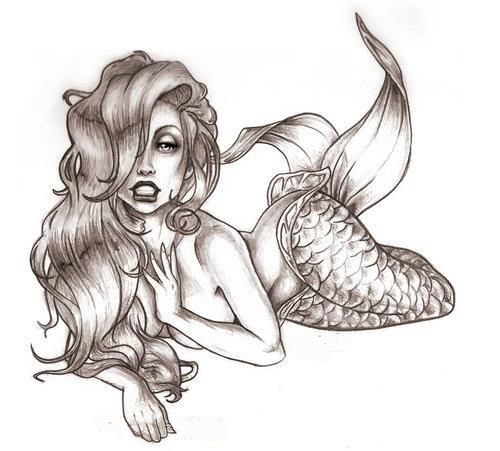
I've Heard the Mermaids Singing
"I've Heard the Mermaids
Singing" is a 1987 comedy-drama film directed by
Patricia Rozema and starring Sheila McCarthy, Paule
Baillargeon, and Ann-Marie MacDonald. The title is
taken from The Love Song of J. Alfred Prufrock by T.
S. Eliot.
The film stars Sheila McCarthy as Polly, a worker
for a temporary secretarial agency. Polly serves as
the narrator for the film, and there are frequent
sequences portraying her whimsical fantasies. Polly
lives alone, seems to have no friends and enjoys
solitary bicycle rides to undertake her hobby of
photography.
Despite her clumsiness, lack of
education, social awkwardness and inclination to
take others' statements literally, all of which have
resulted in scarce employment opportunities, Polly
is placed as a secretary in a private art gallery
owned by Gabrielle (Paule Baillargeon).
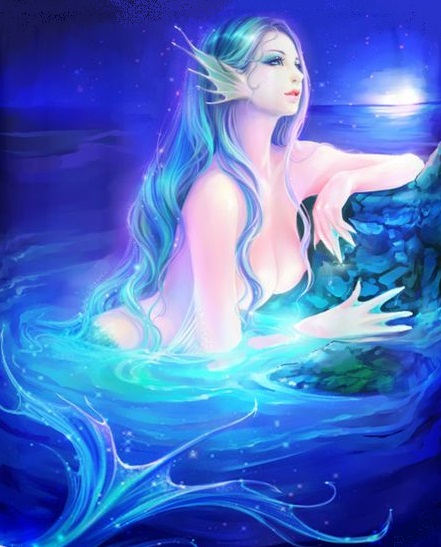
Ann-Marie MacDonald plays Mary,
who is Gabrielle's former young lover, and also a
painter. Mary returns after an absence, and she and
Gabrielle rekindle their former relationship despite
Gabrielle's misgivings that she is too old and Mary
too young. Polly, who's fallen a little bit in love
with Gabrielle, is inspired to submit some of her
own photographs anonymously to the gallery.
She is crushed when Gabrielle
dismisses her photos out of hand and calls them
"simpleminded." Polly temporarily quits the gallery,
and goes into a depression. She returns to the
gallery, and revives a little when Mary notices one
of her photos.
I've Heard the Mermaids Singing
Roger Ebert Reviews Mermaids Singing
Seattle Gay News Reviews Mermaids Signing
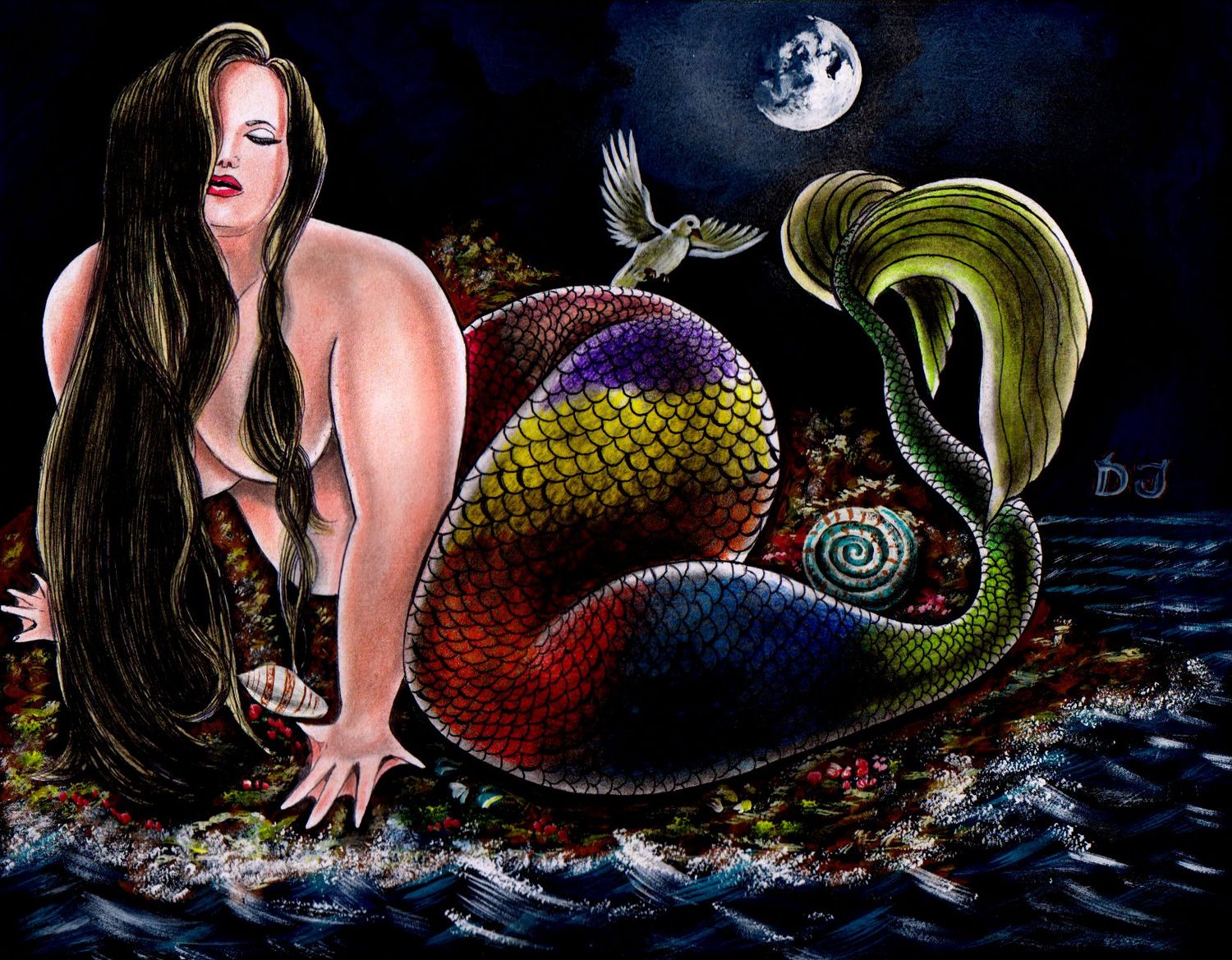
All the while, Mary and Gabrielle have been
perpetrating a fraud. Gabrielle has been passing off
Mary's work as her own. When Polly finds out, she
becomes livid and tosses a cup of tea at Gabrielle.
Believing she has done something unforgivable, Polly
retreats to her flat in anguish.
Mary and Gabrielle later visit Polly at her flat,
and realize that the discarded photographs were by
Polly. As the film ends, Gabrielle and Mary look at
more of Polly's photographs and in a short fantasy
sequence the three are transported together to an
idyllic wooded glen, a metaphor for the beautiful
world that supposedly plain and unnoticed people
like Polly inhabit.
Stella the Siren: Real Life Mermaid
Mermaid Facts
Watch Real Mermaids Swimming
Mermaids and Lesbians
Lexie Mermaid: Cleo
Mermaid Melissa: Swimming With Dolphins
Types of Mermaids
Aquarium of Paris: Mermaid Show
Stella the Siren: Do You Believe in Mermaids?
Underwater Dance
Mermaid Fun Facts
Fantasy Mermaids: Lake Michigan
Natasha Brooks: Blue Hue
Dominic Eagle: Naked Lake
Aquatic Cousins
Sirens - Sirens were popularized by Homer’s
Odyssey. In the epic poem, sirens are vicious
creatures who lure sailors to their death. They sing
a bewitching melody that causes sailors to jump to
their death. They are often depicted as spooky
looking creatures, such as the mermaids in the show
Siren, who resemble wild creatures with spikes and
sharp, jagged teeth.
Selkies - Selkies are similar to mermaids.
They are shapeshifters who change from seal to
human. Selkies are popular in Celtic and Norse
mythology.
Morgens - Morgens are
the most dangerous of Irish folklore. These are
water spirits that are notorious for drowning
unsuspecting sailors and fishermen. They are the
Irish equivalent to the Greek siren and show up in
the form of a beautiful woman. You can spot a Morgan
by her comb. She loves sitting by the water combing
her long hair and singing a seductive tune to
helpless victims.
Finfolk - From the Orkney Islands, northeast
of Scotland, comes the tail of mysterious
water-dwelling shapeshifters called finfolk, or
finnfolk. You may recognize the name from the tail
making company Finfolk Productions. Finfolkaheem is
the name of the underwater home of finfolk. Female
finfolk are born as mermaids and remain that way
into their maidenhood.
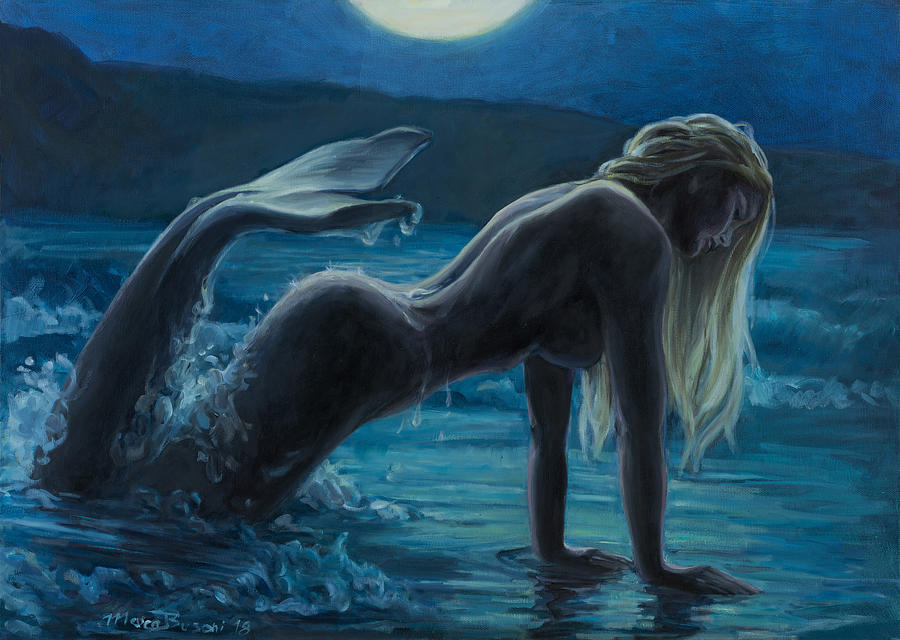
Mermaid Tavern
Mermaid Symbolism
Mermaids and Lesbians
Mermaid Fantasy
Pincoy/Pincoya - In Chiloean mythology,
Pincoya is a female water spirit, and her husband is
Pincoy. Pincoya represents fertility and is
portrayed as a naked woman. She is the daughter of a
sea king named Millalobo. Her sister is a mermaid
named Sirena Chilota. Pincoy is a handsome merman
who resembles a large lionfish.
Ceasg - This creature is a mermaid in
Scottish folklore. She is known to be beautiful and
possess the tail of a salmon. She lives in the sea,
but also can live in streams and rivers. She is said
to grant three wishes to whoever captures her. In
some stories she is more monstrous.
Kelpies - The Blue Men
of the Minch is a popular mythological creature in
Scottish folklore. They are storm kelpies,
shape-shifting spirits that inhabit lakes.
Transceltic described them as “creatures that are
the size and shape of humans, are very strong, and
can be seen swimming and diving”. The Blue Men
challenged ship captains to rhyming and singing
contests. If the captains win, he and the crew would
be left alone in their journey.
Nereids - Nereids are good-spirited sea
nymphs who are the fifty daughters of a sea god
named Nereus. They often came to the aid of those in
distress and were protectors of sailors and
fishermen.
Undines - Undines are
also known as Ondine who dwell in lakes, rivers,
forest pools, waterfalls, and even fountains. These
maidens are very beautiful with gold hair, green
eyes, long tails, and lush lashes. However, she is
missing one important thing, a soul.
Rusalka - Slavic stories of this aquatic
entity date back to the eighth century. Rusalki are
water nymphs who were once human women that died.
They were not always considered malevolent, but the
myths changed through the years to portray the
Rusalka as a sinister creature.

|